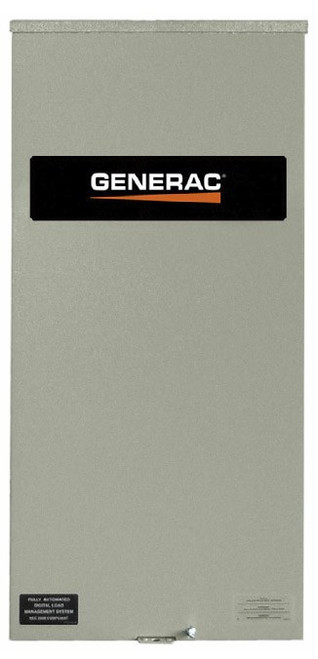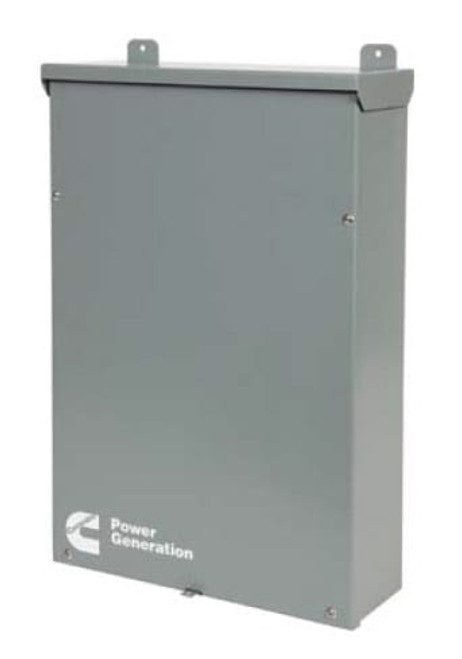Generator Transfer Switch
A Generator Transfer Switch makes the connection between a generator and the electrical circuits in a home or business. Generator Transfer Switches allows a safe, reliable, code-compliant generator installation.
Generator Transfer Switch
A Generator Transfer Switch makes the connection between a generator and the electrical circuits in a home or business. Generator Transfer Switches allow a safe, reliable, code-compliant generator installation for automatic standby generators or portables.
Two different sources of power—the electric utility and the generator—should never meet. Transfer Switches select between the primary source of power (the electric utility) and the generator. They “Transfer” the electrical load from one source to the other by breaking the connection to the first source before connecting to the second source.
Transfer Switch
A Transfer Switch works like a 3-position switch for utility power, off, and generator power. To switch from utility power to generator power, the switch must engage the off position before it selects generator power. This “break before make” type of Generator Transfer Switch isolates the building from the electric utility anytime the generator provides power. Isolation protects the generator from possible catastrophic damage and utility workers and neighbors from unexpected exposure to power from the generator.
Transfer Switch for Generator
Generator transfer switches fit two categories—manual and automatic. Standby or backup generators provide power during an outage and work without human intervention. An automatic generator transfer switch works with the generator to detect an outage, start the generator, and switch the building electrical system to generator power. When the utility restores power, the transfer switch disconnects the generator and reconnects utility power.
Manually operated transfer switches require someone to move the switch from utility power to generator power. In a typical home installation for a portable generator, the owner connects the generator cable to the inlet box and the generator. They start the generator and wait a few moments for the engine to warm. When the generator is ready, the homeowner moves the transfer switch from the utility position to the generator position. When the utility restores power, the operator switches back to utility power and shuts down the generator.
Choosing a Transfer Switch—Generator
A service rated generator transfer switch meets electrical codes to work as a service disconnect. A transfer switch also has a current rating in amps like200-Amps, for example. The transfer switch current rating must equal or exceed equipment rating it serves. A main circuit breaker panel with a 200-Amp main breaker requires a transfer switch for generator with a 200-Amp or higher rating.
The electric utility delivers single-phase power to homes and many small businesses, and three-phase power to larger businesses and buildings. A transfer switch for a generator matches the phase requirements of the building and electrical service it serves.
Standby generator manufacturers build transfer switches designed to work with their generators to implement specific features. To take full advantage of all the generator features, choose a generator transfer switch suggested by the manufacturer. Other models may not work or implement all the features. Packages that include a standby generator and a generator transfer switch save money and guarantee compatibility.
The Best Transfer Switch
Visit our Power-Expert (top menu) for more information on transfer switches and how to choose the best model for your installation. The right generator transfer switch provides a safe and reliable connection for utility and generator power.
Related Generator Transfer Switch Categories
50-Amp Automatic | 100-Amp Automatic | 150-Amp Automatic | 200-Amp Automatic
240-Volt Single Phase | 208-Volt Three-Phase | 240-Volt Three Phase | 480-Volt Three Phase
Manual Switches | 30-Amp Kit | 50-Amp Kit | 100-Amp | 200-Amp | 30-Amp
-

Model #: RXSC200A3
Generac 200 Amp Automatic Transfer Switch Single Phase Nema 3R | RXSC200A3
Norwall's Low Price
$699.00 -

Model #: RXSW200A3
Generac 200 Amp Service Rated Automatic Transfer Switch Single Phase Nema 3R | RXSW200A3
Norwall's Low Price
$809.00 -

Model #: RTSW400A3
Generac 400 Amp Service Rated Automatic Transfer Switch Single Phase Nema 3R | RTSW400A3
Norwall's Low Price
$2,999.00 -

Model #: A064G345
Cummins RA112N3 100 Amp Automatic Transfer Switch | A064G345
Norwall's Low Price
$486.00 -

Model #: 97714-372
ASCO 260-Amp Automatic Transfer Switch Series 185 NEMA 3R | 99714-372
Norwall's Low Price
$3,100.40 -

Model #: 97714-371
ASCO 260 Amp Automatic Transfer Switch Series 185 NEMA 1 | 99714-371
Norwall's Low Price
$2,732.40 -

Model #: 97714-370
ASCO 230-Amp Automatic Transfer Switch Series 185 NEMA 3R | 99714-370
Norwall's Low Price
$2,272.40 -

Model #: 97714-369
ASCO 230 Amp Automatic Transfer Switch Series 185 NEMA 1 | 99714-369
Norwall's Low Price
$2,162.00 -

Model #: 97714-374
ASCO 400 Amp Automatic Transfer Switch Series 185 NEMA 3R | 99714-374
Norwall's Low Price
$3,716.80 -

Model #: 97714-373
ASCO 400-Amp Automatic Transfer Switch Series 185 NEMA 1 | 99714-373
Norwall's Low Price
$3,339.60 -

Model #: 97714-376
ASCO 200-Amp Automatic Transfer Switch Series 185 Service Entrance Rated NEMA 3R | 99714-376
Norwall's Low Price
$2,640.40 -

Model #: 97714-375
ASCO 200-Amp Automatic Transfer Switch Series 185 Service Entrance Rated NEMA 1 | 99714-375
Norwall's Low Price
$2,502.40
-

Model #: RXSC200A3
View DetailsNorwall's Low Price
$699.00 -

Model #: RXSW200A3
View DetailsNorwall's Low Price
$809.00 -

Model #: RTSW400A3
View DetailsNorwall's Low Price
$2,999.00 -

Model #: A064G345
View DetailsNorwall's Low Price
$486.00 -

Model #: 97714-372
View DetailsNorwall's Low Price
$3,100.40 -

Model #: 97714-371
View DetailsNorwall's Low Price
$2,732.40 -

Model #: 97714-370
View DetailsNorwall's Low Price
$2,272.40 -

Model #: 97714-369
View DetailsNorwall's Low Price
$2,162.00 -

Model #: 97714-374
View DetailsNorwall's Low Price
$3,716.80 -

Model #: 97714-373
View DetailsNorwall's Low Price
$3,339.60 -

Model #: 97714-376
View DetailsNorwall's Low Price
$2,640.40 -

Model #: 97714-375
View DetailsNorwall's Low Price
$2,502.40
A Generator Transfer Switch makes the connection between a generator and the electrical circuits in a home or business. Generator Transfer Switches allows a safe, reliable, code-compliant generator installation.
Generator Transfer Switch
A Generator Transfer Switch makes the connection between a generator and the electrical circuits in a home or business. Generator Transfer Switches allow a safe, reliable, code-compliant generator installation for automatic standby generators or portables.
Two different sources of power—the electric utility and the generator—should never meet. Transfer Switches select between the primary source of power (the electric utility) and the generator. They “Transfer” the electrical load from one source to the other by breaking the connection to the first source before connecting to the second source.
Transfer Switch
A Transfer Switch works like a 3-position switch for utility power, off, and generator power. To switch from utility power to generator power, the switch must engage the off position before it selects generator power. This “break before make” type of Generator Transfer Switch isolates the building from the electric utility anytime the generator provides power. Isolation protects the generator from possible catastrophic damage and utility workers and neighbors from unexpected exposure to power from the generator.
Transfer Switch for Generator
Generator transfer switches fit two categories—manual and automatic. Standby or backup generators provide power during an outage and work without human intervention. An automatic generator transfer switch works with the generator to detect an outage, start the generator, and switch the building electrical system to generator power. When the utility restores power, the transfer switch disconnects the generator and reconnects utility power.
Manually operated transfer switches require someone to move the switch from utility power to generator power. In a typical home installation for a portable generator, the owner connects the generator cable to the inlet box and the generator. They start the generator and wait a few moments for the engine to warm. When the generator is ready, the homeowner moves the transfer switch from the utility position to the generator position. When the utility restores power, the operator switches back to utility power and shuts down the generator.
Choosing a Transfer Switch—Generator
A service rated generator transfer switch meets electrical codes to work as a service disconnect. A transfer switch also has a current rating in amps like200-Amps, for example. The transfer switch current rating must equal or exceed equipment rating it serves. A main circuit breaker panel with a 200-Amp main breaker requires a transfer switch for generator with a 200-Amp or higher rating.
The electric utility delivers single-phase power to homes and many small businesses, and three-phase power to larger businesses and buildings. A transfer switch for a generator matches the phase requirements of the building and electrical service it serves.
Standby generator manufacturers build transfer switches designed to work with their generators to implement specific features. To take full advantage of all the generator features, choose a generator transfer switch suggested by the manufacturer. Other models may not work or implement all the features. Packages that include a standby generator and a generator transfer switch save money and guarantee compatibility.
The Best Transfer Switch
Visit our Power-Expert (top menu) for more information on transfer switches and how to choose the best model for your installation. The right generator transfer switch provides a safe and reliable connection for utility and generator power.
Related Generator Transfer Switch Categories
50-Amp Automatic | 100-Amp Automatic | 150-Amp Automatic | 200-Amp Automatic
240-Volt Single Phase | 208-Volt Three-Phase | 240-Volt Three Phase | 480-Volt Three Phase
Manual Switches | 30-Amp Kit | 50-Amp Kit | 100-Amp | 200-Amp | 30-Amp
